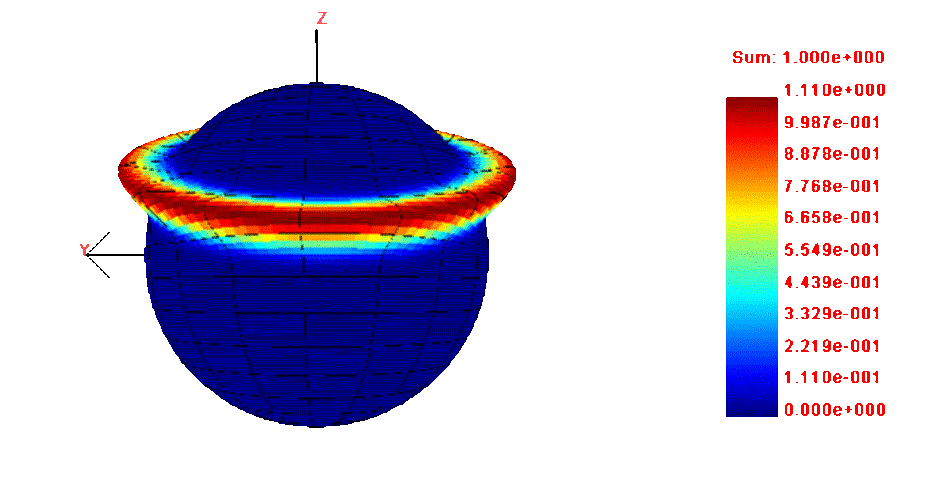Current Research Projects
Detector Team (Sponsored by Defense Threat Reduction Agency, DTRA)
Researchers: Yuefeng Zhu PhD, Gianluigi De Geronimo PhD, Zhuo Chen, Matthew Petryk, Sara Abraham, and Damon Anderson
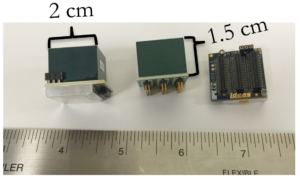
Digital Signal Processing (DSP) Application-Specific Integrated Circuit (ASIC)
New waveform sampling ASICs incorporate 130 miniature oscilloscope channels in a tiny package, reading out detailed information from front-end detectors. These waveform signals require special processing to extract information about incident radiation. Current FPGA and computer systems that carry out this processing are bulky and power hungry.
We are developing a new type of chip, which packs the processing capabilities needed into a small package of 4×4 mm. Developed in collaboration with Professor Michael Flynn’s group in EECS, the new chip includes a state of the art analog-to-digital converter, as well as multiple programmable digital filters and supporting circuitry. This will allow a new level of miniaturization for high resolution gamma-ray detectors.
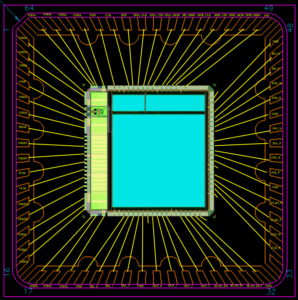
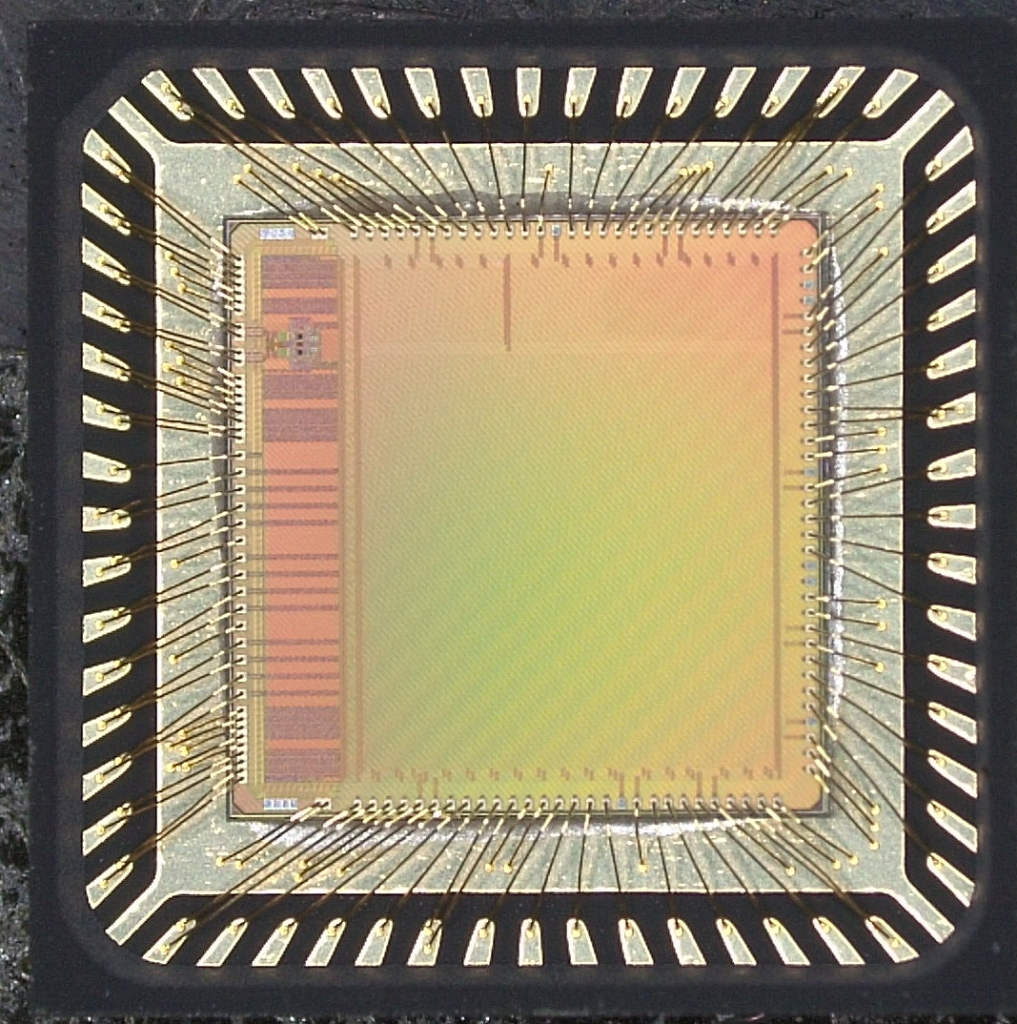
H3D Digital (H3DD) ASIC
The next generation of low noise front end electronics is being developed and tested in the Orion Group. The H3DD ASIC is a waveform sampling ASIC, capable of sensing the movement of hundreds of electrons inside a crystal which contains billions of them. A radiation interaction inside a CZT crystal liberates a cloud of electrons, the signals from which are amplified and recorded by the H3DD ASIC as anode and cathode waveforms. This ASIC pushes the noise floor ever lower and will allow CZT based detectors to reach into the range of <2keV total noise, to rival the performance of high purity germanium detectors without the need for cryogenic cooling.
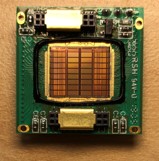
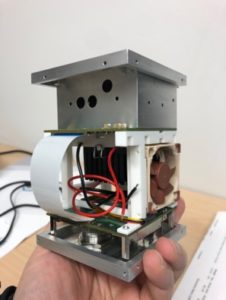
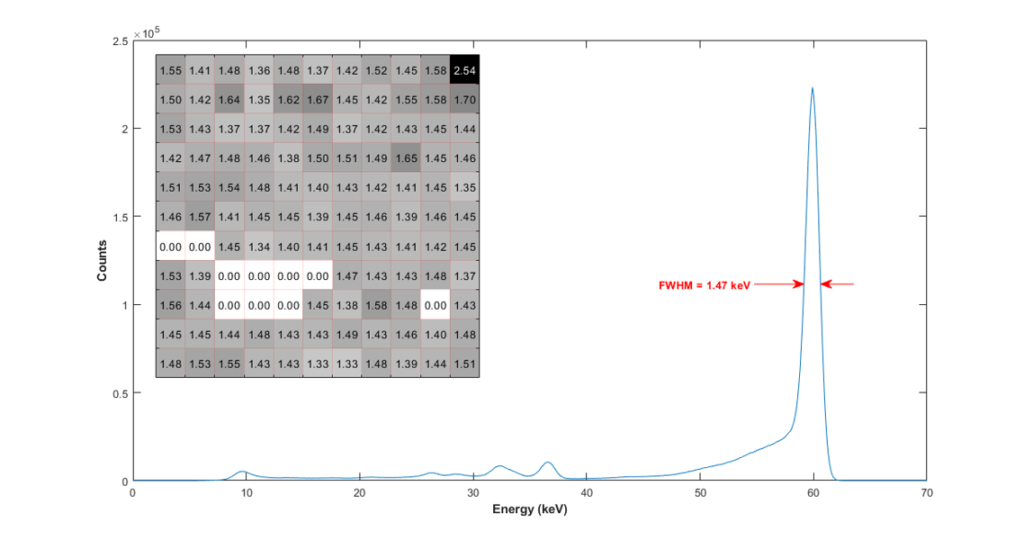
Large CZT detectors
We are developing readout systems for and testing the world’s largest single-crystal CZT detectors. At 4 x 4 x 1.5 cm with 484 pixels per crystal, we are approaching a situation where the bulk of the mass of a detector system is in the detector crystal itself. Large crystals provide benefits over arrays of smaller crystals of similar total volume, such as larger active area and increased efficiency.
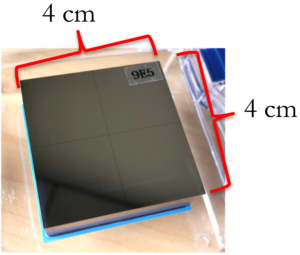
Thermal Effects and Neutron Effects on CZT
Neutron damage and thermal effects both change the response of CZT-based radiation detectors in complicated ways. We are developing methods for on-the-fly temperature corrections, with a goal of removing the need for any active temperature regulation. This can save weight and power, especially important for mobile systems. We are also characterizing and understanding the effects of high neutron fluxes on CZT, and exploring lattice healing through high-temperature annealing.
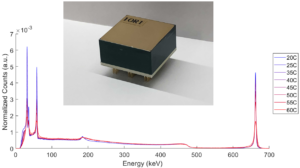
NASA Balloon Project
In collaboration with Los Alamos National Laboratory (LANL), we are preparing a CZT detector system to measure space gamma rays from a high altitude NASA balloon. These high altitude measurements will provide us with new opportunities to develop algorithms for particle ID, as well as characterize our detectors in a unique space-like environment.
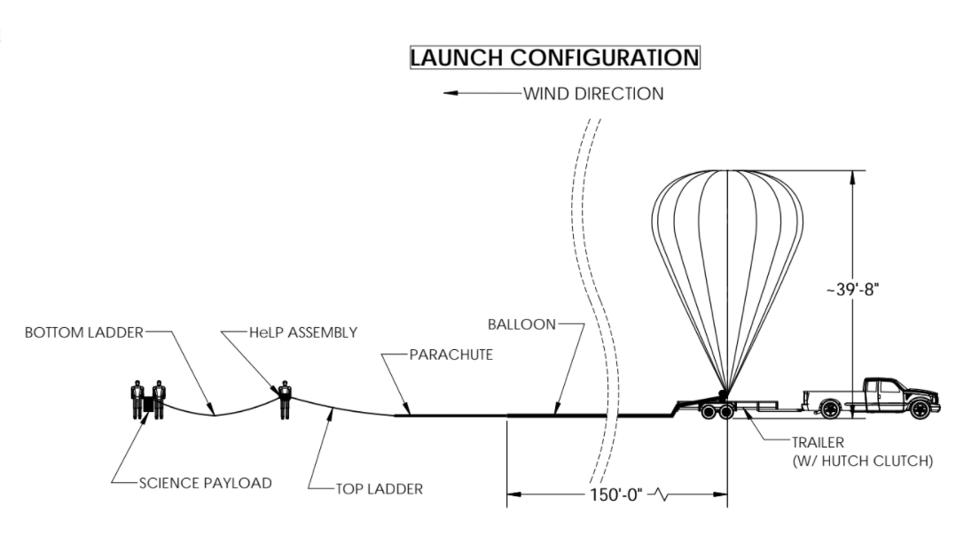
Super-MeV Gamma Ray Spectroscopy
CZT’s “sweet spot” lies in the several hundred keV range, up to 1 MeV. At high energies, new effects become significant that can degrade the resolution of normally high performant detectors. We are carrying out measurements and developing algorithms for accurate and precise spectroscopy up to 9 MeV and beyond. High energy spectroscopy is important in many applications, including astrophysics and medical imaging.

CZT Detector Efficiency
High energy resolution isn’t the only desirable quality of a radiation detector. A longstanding effort is investigating the mechanisms that can lead to lower than expected efficiency under different situations. This is a multi-pronged effort involving the development of detailed simulation packages, as well as very careful and precise experiments. We track down event loss and investigate the dead time across a range of source energies and activities.
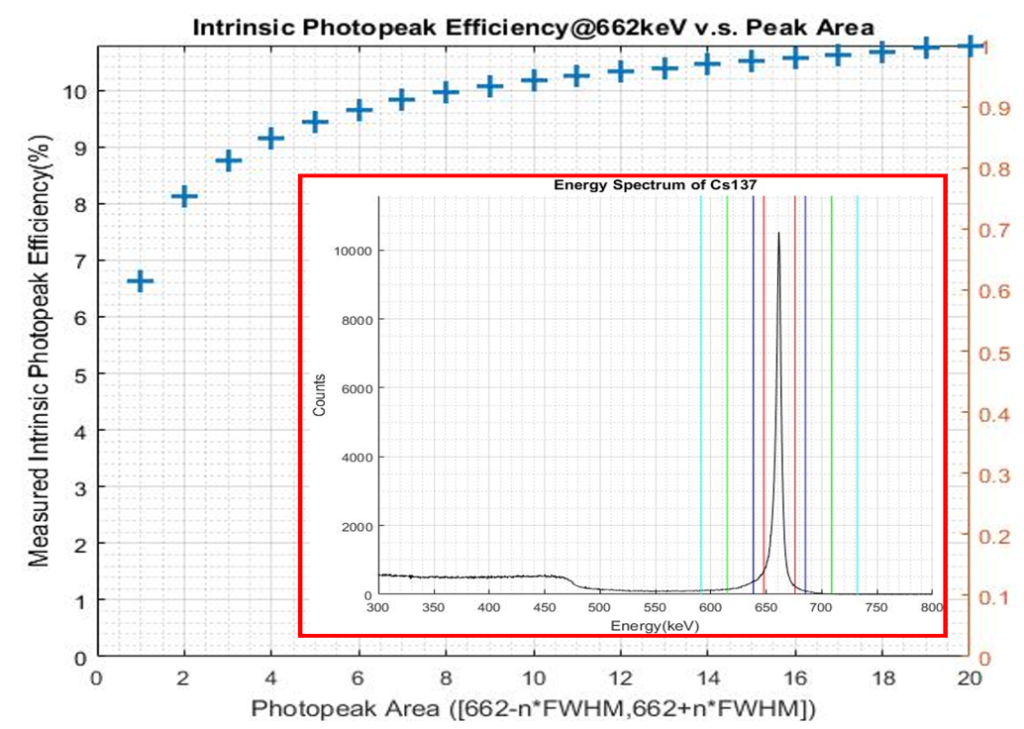
Gamma-Ray Imaging Team (Sponsored by NA-22, National Nuclear Security Administration (NNSA))
Researchers: Daniel Shy, Valerie Nwadeyi, and Alexander Rice
The pixelated CZT detectors developed by our group provide 3-D positions and energy depositions of gamma-ray interactions within their volume. This detailed information allows us to determine the incident direction of gamma rays, based on the physics of their interactions with the CZT. We use both Compton and coded-aperture imaging techniques to determine the spatial distribution of gamma-ray emitting materials around our detectors.
The focus of the imaging group is to develop new imaging techniques and algorithms for real-world applications. Past research includes real-time tracking of moving objects, 3-D mapping of gamma-ray emissions inside a room, source detection algorithms, and imaging high energy (>3 MeV) gamma-rays. Recent collaboration includes work with NASA for imaging gamma rays from neutron-activated materials as well as measurements with researchers interested in imaging gamma-rays emitted from tissue during proton cancer therapy. Knowledge of the uncertainty and physics of interactions in our detectors also enables us to develop more advanced, iterative reconstruction techniques and to solve inverse problems to characterize gamma-ray emitting materials such as special nuclear material (SNM). Recent work on neutron detection via cadmium capture in our detectors has also expanded our capability to location of neutron-emitting sources.
Another project has the goal to achieve robust, direction-dependent isotope detection using large volume CdZnTe gamma-ray detectors. In this work, data from both Compton and coded aperture imaging are combined in a probability-based algorithm to solve for gamma-ray spectra as a function of direction. In collaboration with Sandia National Laboratories, the well-established GADRAS (Gamma Detector Response and Analysis Software) will utilize this data to autonomously detect isotopes of interests and point to their direction. Of interest is the ability of directional information to improve the discrimination of background from isotopes of interest. Although this technology is designed with homeland security in mind, a range of other applications can be imagined: from space to medical imaging and radiation protection.
Advanced Algorithms
A number of advanced image reconstruction algorithms provide benefits over the simple back-projection often used. These include inverse methods like Filtered Back-projection (FBP), iterative methods like Maximum Likelihood Expectation Maximization (MLEM), and Time-Encoded Imaging (TEI) for lower energies. Challenges include accurate system modeling, proper image reconstruction in a variety of field conditions, and system optimization for image resolution targets.
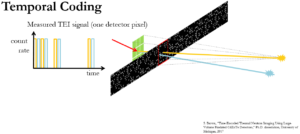
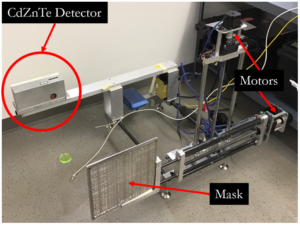
Proton Cancer Therapy
Researcher: Valerie Nwadeyi
This is an exciting new field of radiation therapy that utilizes the precision of the proton Bragg peak to target and destroy cancerous tissue. However, there is a strong need for in vivo dose verification with millimeter accuracy to ensure that the proton dose is delivered to the correct location within the patient. This is especially true for high-risk treatments near critical organs. It has been shown that prompt gamma rays offer fine position resolution information since the secondary gamma emission distribution follows the proton dose distribution very closely. In collaboration with Professor Jerimy Polf’s group at the University of Maryland School of Medicine’s Department of Radiation Oncology, we have taken preliminary measurements of prompt gamma-rays ranging in energy up to 6 MeV from proton beams using a 64-CdZnTe-crystal analog detector system, provided by H3D. Work on this topic continues as initial results indicate there is a promising future for this technology.
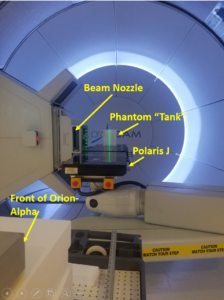

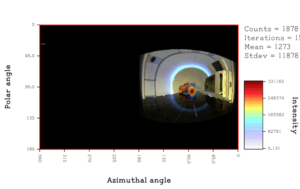
Quantification of Nuclear Material Holdup
In collaboration with Justin Knowles PhD of Consolidated Nuclear Security, LLC and Y-12 National Security Complex, use imaging techniques to check for buildup of nuclear material in opaque pipes in order to prevent blockage. This project offers new opportunities to test our reconstruction algorithms with complex, extended sources.
Consortium for Monitoring, Technology, & Verification (MTV)
During July 2019, students Daniel Shy and Zhuo Chen and their summer intern, Cadet Brendan Huhlein of USMA, conducted a week-long measurement campaign at Idaho National Laboratory. The goal was to verify the performance of new 3D imaging algorithms, which can build a map of the radiation distribution in 3D space.
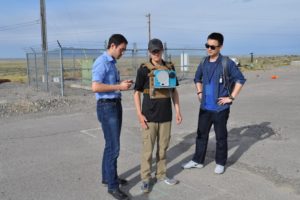
Source position estimation without GPS is performed with a commercial detector, the H3D Polaris H420, and an inertial measurement unit (IMU) attached to the shoe of the user. The algorithms are able to reconstruct the location of various radiation sources in 3D as the operator walks a search path.
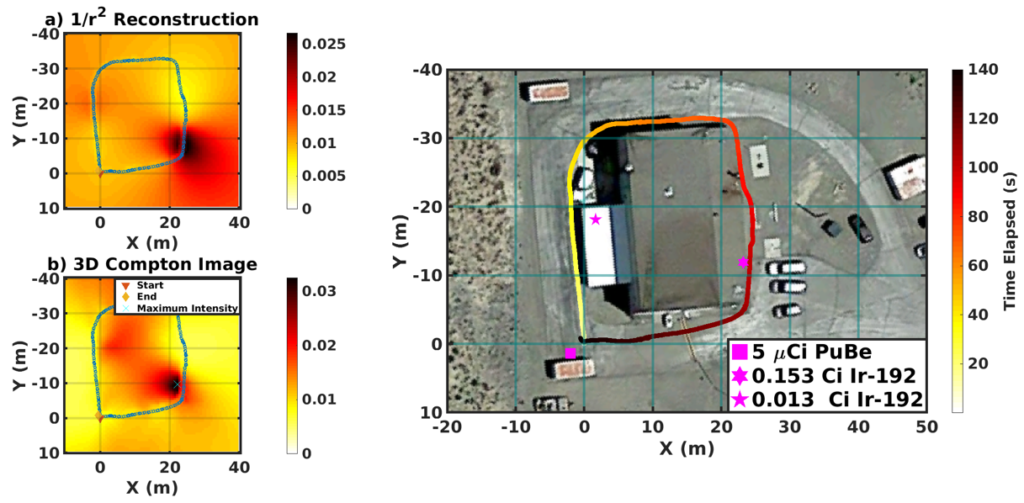
Thallium Bromide (TlBr) Gamma-Ray Spectrometers (DHS CWMD, RMD, and LLNL)
Researchers: Charles Leak, Matthew Petryk, and Erik Hall
TlBr is an attractive material for room-temperature gamma-ray spectroscopy because of its high stopping power, wide band-gap, and low melting point. In collaboration with Radiation Monitoring Devices, Inc. (RMD) and Lawrence Livermore National Laboratory (LLNL). Spectrometers have achieved < 1% FWHM at 662 keV but these results are limited to stable operation at -20 °C. Degradation over time (referred to as polarization) occurs in TlBr devices after hours to months of room-temperature operation. Our group’s goal is to characterize the polarization phenomena to help manufactures improve the lifetime of TlBr detectors.
In addition to room-temperature characterization, our team also tests detectors at -20 °C where they can operate indefinitely. We write new software algorithms to deal with material-specific characteristics like the relatively high hole mobility and are currently developing a portable two-stage cooling system. Our goal is to move to the digital ASIC readout system currently used on CZT.
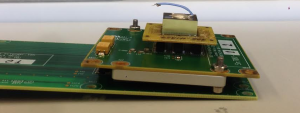
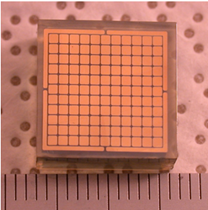
CsPbBr3 Radiation Detectors
A new material to high energy gamma ray detection, CsPbBr3 has already made a name for itself in the field of solar power. It is a perovskite, a class of crystals seeing increased research interest in the past two decades. In collaboration with Northwestern University, we reported the highest resolution attained to date by perovskite-based detectors at Cs energies, around 1.4% at 662 keV. The relative stability, low manufacturing cost, extremely long hole lifetimes, potential for low-bias operation, and possibility of bipolar carrier sensing make CsPbBr3 detectors attractive candidates for next generation radiation detectors.

Alternative Material Semiconductors
In addition to TlBr and CsPbBr3, we also collaborate with other universities, private companies, and national laboratories to characterize crystals they have fabricated. To date, these include CdZnTeSe (CZTS) and other perovskites such as MAPbBr3. In the past, we have also developed HgI2 detectors.
Past Research Projects
Consortium for Verification Technology (CVT) 2017
During August 2017, students David Goodman and Jiawei Xia conducted a week-long measurement campaign at Idaho National Laboratory. High resolution, ~1.5mm, time-encoded images were generated of ZPPR plates and MOX fuel pins using the MIRA system. High energy resolution spectra using digital, room temperature CdZnTe systems can be used to measure plutonium isotopics.
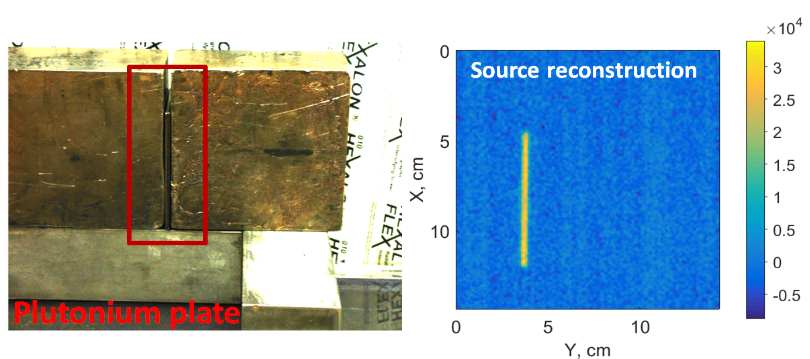
Left: ZPPR plutonium plate in bismuth collimator. Right: High resolution (~1.5mm), time encoded image generated in 30 minutes.
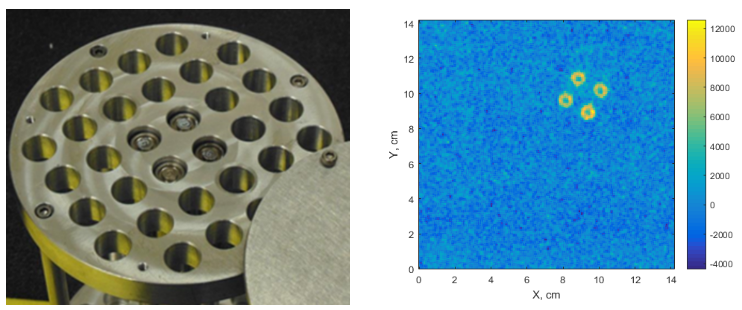
Left: Four MOX pins in an aluminum holder. Right: Time encoded reconstruction
Researchers: David Goodman, Bennett Williams, and Jiawei Xia
Real-Time Compton Imaging and Autonomous Source Searching
With the information of the detector position and orientation, it is possible to locate the back-projected Compton cones and estimate the source distribution in a 3D space. However, since the mesh size of a typical 3D imaging space and the number of collected events are both very large, the speed of reconstruction is limited and the memory usage is not practical for iterative algorithms. To accelerate the 3D reconstruction, an incremental iterative algorithm was applied, which provides real-time reconstruction speed while preserving reasonable statistics. Environmental information was fused to exclude voxels in the air and build a sparse 3D imaging space. We collaborated with Carnegie Mellon University by mounting a single-crystal detector on a robot with optical cameras and a LiDAR scanner, to achieve real-time 3D Compton imaging and autonomous source searching.
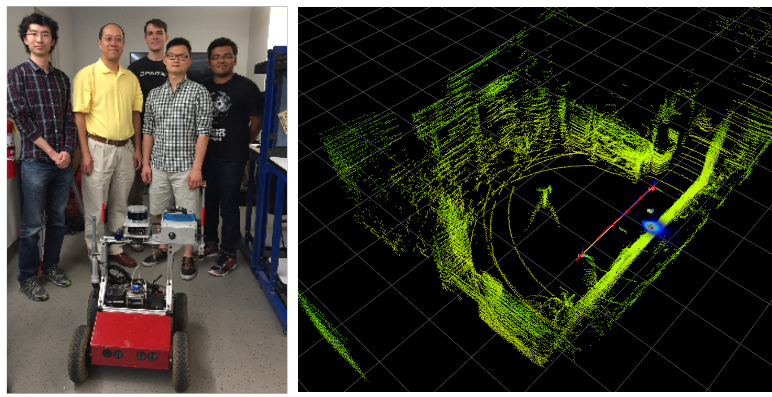
Researchers: Jiyang Chu in collaboration with Carnegie Mellon University
Thermal Neutron Imaging (DOE NNSA NA-22)
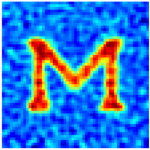
Thermal neutron imaging is a new-developed capability for CdZnTe that allows us to locate and discern the shape of low-Z material near neutron-emitters such as plutonium. By detecting the interaction locations of cascade gammas following neutron capture on 113Cd, it has been shown that a directional “pointer” can be used to estimate the direction to a thermal neutron source. A special moving coded aperture mask technique is also under development, allowing us to obtain high-resolution images of stationary extended sources.
Researchers: Steven Brown
Long-term stability of CdZnTe detectors is studied in a low background cave designed to hold the first Polaris system. Continuously collected data are used to determine the performance of the system over time, these data can also be used to study the potential application of CdZnTe to measurements of low activity sources or other applications that require extremely low backgrounds.
Researchers: Andy Boucher
Polaris 3-D Position-Sensitive CdZnTe Gamma-Ray Imaging spectrometers (DOD DTRA, DOE NA-22)
Develop room-temperature CZT semiconductor gamma-ray spectrometers, with energy resolution of better than 1% at 662keV.
Researchers: Feng Zhang, Andy Boucher, Josh Mann, and Jim Berry
Digital 3-D semiconductor gamma-ray spectrometers (DOD DTRA, DOE NA-22)
Develop digital acquisition system for room temperature CZT and alternative semiconductor gamma-ray spectrometers.
Researchers: Feng Zhang, Yuefeng Zhu, Hao Yang, and Michael Streicher
Exploration of alternative room-temperature semiconductor gamma-ray detectors (Radiation Monitoring Devices and DNDO of DHS)
Develop alternative wide band-gap semiconductor radiation detectors from materials such as HgS, HgO, TlBrI and InBrI.
Researcher: Crystal Thrall and Will Koehler
Feasibility study on neutrino-less double-beta decay measurements
Fundamental science/basic physics investigation.
Researcher: Feng Zhang and Andy Boucher
Study on high count-rate gamma-ray spectroscopy using 3-D CdZnTe detectors (DOE NA-22)
Simulate and measure pulse waveforms under high flux applications where the variation of space charge and the signal induction from charge drift cannot be decoupled.
Researcher: Meisher Rodrigues
Feasibility study on measuring elemental compositions of planetary bodies using 3D CdZnTe gamma-ray imaging spectrometer (NASA Goddard Space Flight Center)
Determine the feasibility of identifying the elemental composition of Mars and the Moon using spectra obtained from 3D CdZnTe gamma-ray imaging spectrometry.
Researcher: Andy Boucher and Steven Brown

